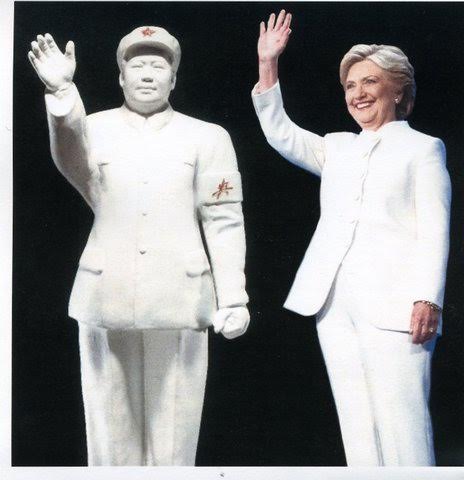
Nobody has accused Hillary Clinton of setting an example of how to dress for success, and certainly not for fun. She's clearly no Melania Trump. But she may be assisting the Chinese in bring­ing back "the Mao suit." She probably shouldn't expect a standing ovation from men.
That would suit her, so to speak, just fine. She often echoes the feminist line that women shouldn't have to bear men look­ing at them. Who can see a brilliant mind under a tunic but­toned to the chin, accompanied by baggy pants that might hide who knows what.
The Mao suit, or what the Chinese call "the Zhongshan suit," was originally meant to cover "the classless society," and it makes a comeback from time to time in China. Hillary's Mao suit, though modified, does not hide or disguise its origins. It looks like it was designed in New York or even Paris (meaning it probably costs a lot, despite the cut of its jib), but it's still a Mao suit, so far without the winter quilt effect once fashionable in Tiananmen Square (without the tanks) .
When Chinese President Xi Jinping was guest of honor at a state dinner in the Netherlands he wore what the state-run China Daily called "an elegant dark-blue Mao suit," and gushed that "Zhongshan suit makes a comeback." One commentator said it was a sign of "national authority, na­tional pride and national ritual." That was a decade and more ago, but time moves slowly in the Ancient King­dom. Hillary and her dressmaker couldn't have imagined it better.
The prosperous young in China don't want to have anything to do with the Mao suit, though if Hillary is elected president of the United States they might change their minds. Aping American fads and fashions is a worldwide obsession. Mao suits are available on the Internet for $149.95. Hill­ary's probably cost more than that, but who can tell?
The suit became sort of fashion­able among the left-wing intellectuals in the '60s and '70s, when Marxism was in flower, and after the horrors of the Cultural Revolution came to light Hol­lywood made the Mao suit infamous in the James Bond movies, particu­larly with Ernst Stavro Blofield, a caricature of evil. He, too, craved to dominate everyone.
When Mao took over China in 1949 he prescribed the Mao suit as an alterna­tive to both the Western business suit and the Manchu robe, each with wasteful or feudalistic connotations. The Mao suit was utilitarian. Nearly everyone could afford one, and the cut disguised any hint of what lay beneath. No sex, please, not anymore. Hasn't China had enough of that? The suit came in pale blue, green and gray. Chairman Mao's usually had four pockets, representing the four cardinal principles of the Chinese Book of Changes: Propriety, justice, honesty and a sense of shame. Not exactly a suit for Hillary, one might say.
Still, everyone had to wear one to avoid standing out in the crowd, and in China, a crowd was really a crowd. It became the uniform of the Red Guards, who set out to destroy ancient and classic Chinese culture, and made a lot of headway. If they knew what was good for them, men and women dressed to be serviceable and sex­less, making the world safe for feminists. Perhaps this was the rough inspiration for the slob look that eventually became the norm in much of the West, as any frequent flyer could tell you.
Mao imagined that his prescribed dress would introduce the classless society, but even he couldn't eliminate the notion that rank has its privileges. The peons got a Mao suit of rough and coarse cotton, which gave them the pleasure of scratch­ing. Peons didn't get much else. Middle managers got polyester, surely more punishment than reward, and the top of the line party executives got a luxurious wool.
After Mao died in 1976 the appeal of the Mao suit began to fade, though not everywhere. The Metropolitan Museum of Art in New York mounted an exhibition of what it called "West­ern fantasies about China through fashion." The Mao jacket, the curator told The Washington Post, was "the last sartorial symbol of China. Sub­sequently, no other item of clothing screams China."
Hillary's pants suits sometimes scream, too, particularly when she marches stiffly into a room, or on to a debate stage. Nevertheless, she may rescue the Mao suit a second time, and give it legs - thick, sturdy legs to take it to unimagined heights of fashion. That's only if she wins. If the Donald prevails - the post-debate polls suggest he's not done yet - the Melania look is likely to prevail. She would look good even in a pants suit.
Comment by clicking here.
JWR contributor Wesley Pruden is editor emeritus of The Washington Times.


 Contact The Editor
Contact The Editor
 Articles By This Author
Articles By This Author